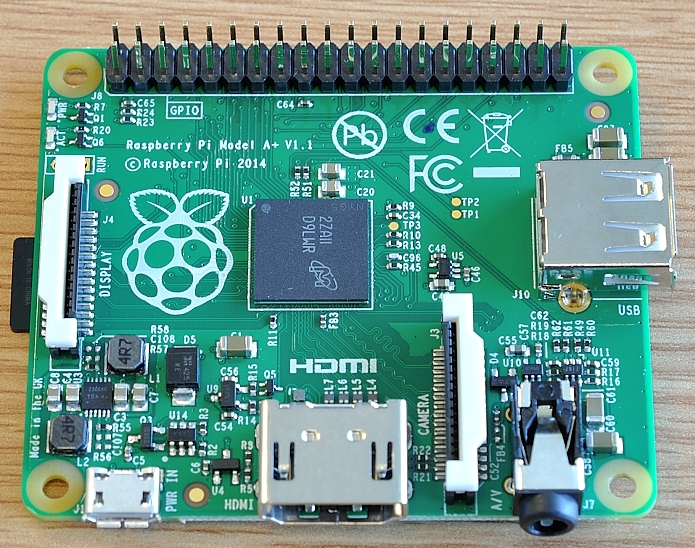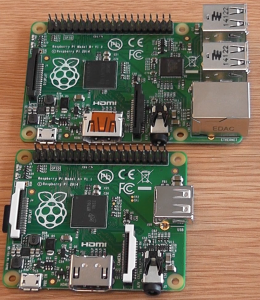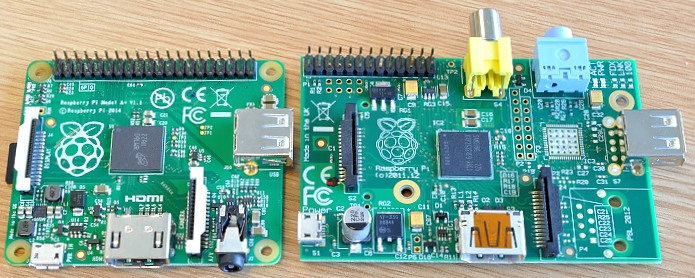
Today, Raspberry Pi launches its new Raspberry Pi A+. Just like the model B was upgraded to B+, the model A now gets some love.
So what’s it like? Essentially, it’s like a model B+ with the USB and networking end cut off. When I was at Raspberry Pi HQ a couple of weeks ago, I was allowed (under strict NDA and embargo) to shoot some photos and video. Here’s what it looks like…
So What’s New & Different?
The first three are the main changes – size, weight and cost. The rest are pretty much the same as the changes from model B to model B+…
- Smaller board dimensions 66 x 56 x 14mm (model A = 92 x 64 x 18mm)
- Lighter weight 23g (model A = 31g)
- Lower price $20 + shipping and local taxes (model A $25 + s & t)
- 40 pin header
- 4 mount holes (HAT compatible)
- Improved power circuitry – switching regulators. This will give a small improvement vs the model A
- Composite and stereo audio on a single 4-pole 3.5mm connector
- Metal micro-SD card slot
- Connectors on only two sides
Let’s Have A Good Close Look At The A+
So What Hasn’t Changed?
It still has a single USB port, HDMI out, CSI, DSI, micro-USB power in and a BCM2835 SoC.
The A+, like the A before it, has 256 Mb RAM. I asked Eben if they’d considered bumping up the 256 Mb RAM to 512 Mb. He replied that it was a possible choice, but they preferred to be able to reduce the price to $20 instead.
I think it’s pretty darned impressive to be able to hit that price point. And it also ‘cocks a snook’ at the people who sneered at the original $25 price point (I remember some ‘vaporware’ accusations in the early days).
What About HATS?
You might have noticed that the A+ is exactly the same size as a HAT. That’s no accident. You’ll be able to make neat little systems out of an A+ and a HAT.
Why Would Anyone Want One?
- Cost – it’s only $20. If you need the cheapest fully functional Pi, this is the one for you.
- Size – it’s the smallest fully functional Pi available. The compute module is smaller, but the A+ has all the connectors on and needs no ‘mother-board’
- Weight – at just 23g, Dave Akerman and other high altitude balloonists will be all over this. For wearables, flyables or any other ‘ables’ where weight is a consideration, this is the lightest fully functional Pi available.
So if you need smaller, lighter or cheaper, the A+ is probably the Pi of choice for you.
If You’re A Collector
If you need a reason to buy an A+ immediately, or you’re a collector, the first 20,000 will be slightly more special. The first batch of boards have gold-plated pads, like previous Pis to date. But after those first 20k, the rest will not have gold pads. This helps to keep the cost down. Apart from the RUN header, there really aren’t any pads to solder to on the A+.
It’s Only $20
This is the big story really. A lot of people have guessed the form factor, shape, size and features of the A+ from the information gradually given out by Raspberry Pi and, in the last few days, leaked by distributors. Last week, someone even tweeted a photoshopped mock-up which made me double-take, before I realised it was ‘shopped.
This $20 price point drives down the cost of computing even more. It really is quite an exciting achievement.
I just bought 2 at Farnell for £37.22 delivered. So that’s £18.61 each. When they get here, I’ll do some testing.



[…] Photo credit: Alex Eames from RasPi.TV […]
Thanks, Alex – as clear and informative as ever! I use A’s for battery powered robots and I’ve been waiting for this since the announcement of the B+. I was expecting the better power handling, expanded GPIO and the mounting holes – all good news for us amateur roboticists – but the smaller form factor is a surprise and a real bonus. Not to mention the price, although like you I bought two – it’s the simplest way of getting over Farnell’s £20.00 minimum.
[…] His blog post can be found over at RasPi.TV. […]
Is there a way to get one shipped to the US, they are not on the Newark/Element 14 US page yet.
I think thepihut.com are shipping worldwide
“The compute module is smaller, but the A+ has…”
The longest dimension on the A+ is actually slightly shorter than the longest dimension on the ComputeModule :)
That’s true, but the compute module (by itself) has a lot less volume. I say it’s smaller (but not in all 3 dimensions), :)
If you made a custom board to make it usable, it’d probably end up bigger, depending on what connectors you wanted.
Heheh, nice to know there’s someone just as pedantic as me ;-D
[…] RasPi.TV blog has more details and photos of the new Raspberry PI […]
I’d like. To get my greedy hands on one, but I must first master the B+
I would have loved it more if it would have been slimmer as well :)
Instead of having vertically arranged USB ports, horizontal array will be a great mod to use with projects like piPhone etc.
Personally I would love to have a pi Powered pocket computer :)
It only has one USB port and it is a horizontal one.
Alex Did you ever find a good point to input a 5V to the A+ instead of the micro usb. As today I purchased dummy CCTV camera on offer at Lidl for under £6. I have fitted a camera board and Model A+ inside the plastic case water proof to IP44. The pcb just fits inside but you loose the use of the USB socket so expect the only place is the GPIO pin. Tried to find a schematic but only for A,B,B+ on raspberrypi.org. As it is plastic hoping a wireless dongle will work inside. It has a battery compartment for 2xAA so going to try a 3V to 5v board as well. A second look at the PCB on bottom at the F1 fuse may give a solder pad to fix to. Camera has a dummy tube looking like a lead and it is hollow so a cable could go up into the case
TerryR
GPIO pins 2 and 4 are 5V pins and I think you can power the pi through those. :)
Yup, pinout for the GPIO header on A+ is identical to GPIO header on B+ https://raspi.tv/2014/rpi-gpio-quick-reference-updated-for-raspberry-pi-b
It’ll be interesting to hear what kind of run-time you get off just 2 AA batteries, maybe you could do some back-of-the-envelope estimates using https://raspi.tv/2014/raspberry-pi-a-how-much-power-does-it-need
I have just installed the 3>5V pcb getting 5.2V with 2 alkaline. I have dug out some 2500 NiMH from Maplins will have to charge them up and sort out a MicroSD should be able to do a live test on Wednesday. Gone for the GPIO pins with 2 female jumper leads should be able to take some current measurements.
TerryR